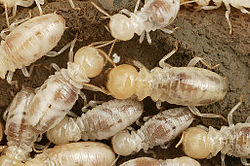| Mastotermitidae | |
|---|---|
 | |
| Mastotermes darwiniensis | |
| Scientific classification | |
| Kingdom: | Animalia |
| Phylum: | Arthropoda |
| Class: | Insecta |
| Order: | Blattodea |
| Infraorder: | Isoptera |
| Family: | Mastotermitidae Desneux 1904 |
| Genera | |
See text | |
Mastotermitidae is a family of termites with one sole living species, Mastotermes darwiniensis which is found only in northern Australia. The remaining genera of this family are only known from the fossil record.